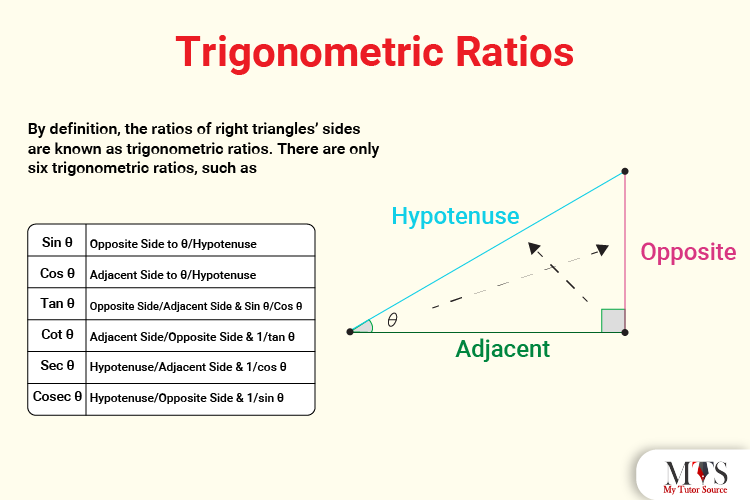

Scholars worldwide have studied Trigonometry as it is one of the most ancient subjects. Trigonometry deals with measuring triangles’ sides, angles and problems based on them. The word trigonometry is generated from words of the Greek language: trigonon and metron, which means triangle and measure, respectively. It covers a part of mathematics, and learning trigonometric ratios is essential to understand the relationship between angles and sides of a right-angled triangle. Therefore, experienced teachers and private math tutors around the globe conduct lectures on trig ratios.
There are six trigonometric ratios for right-angled triangles with respect to their acute angles. Let us understand the concept of trigonometric ratios with their formulas from the information given below:
By definition, the ratios of right triangles’ sides are known as trigonometric ratios. There are only six trigonometric ratios, such as
Here,
Cosecant or Cot is the multiplicative inverse of Sin or Sine.
Secant or Sec is the multiplicative inverse of Cos or Cosine.
Cotangent or Cosec is the multiplicative inverse of Tan or Tangent.
As triangles have three sides, these ratios are used to find any of the two sides of the given triangle. They are also used to measure the acute angle, θ of the right-angled triangle. All triangles have a
As per the definition, the perpendicular, hypotenuse and base refer to the lengths of the sides of the right-angled triangle. Go through the table given below to learn the basic formulas of trigonometric ratios:
Trigonometric Ratios Formulas | |
| Sine or sin θ | Perpendicular / Hypotenuse |
| Cosine or cos θ | Base / Hypotenuse |
| Tangent or tan θ | Perpendicular / Base |
| Cotangent or cot θ | Base / Perpendicular |
| Cosecant or cosec θ | Hypotenuse / Perpendicular |
| Secant or sec θ | Hypotenuse / Base |
Observe the formulas of trigonometric ratios in-depth, and you will determine that all these formulas are somehow generated from each other. For instance, cosine or cos θ is the reciprocal of secant or sec θ.
Following is the table of the new set of trigonometric ratios formulas:
Trigonometric Ratios Formulas | |
| Sine or sin θ | 1 / cosec θ |
| Cosine or cos θ | 1 / sec θ |
| Tangent or tan θ | 1 / cot θ |
| Cotangent or cot θ | 1 / tan θ |
| Cosecant or cosec θ | 1 / sin θ |
| Secant or sec θ | 1 / cos θ |
The standard angles of trigonometric ratios are 0°, 30°, 45°, 60°, and 90°. Using the table given below, calculating values of different angles of trigonometric ratios becomes easy. Students must learn the value of specific angles for quick calculations.
It is one of the easy ways to learn and memorize formulas and definitions of three trigonometric ratios i.e., sin, cos and tan.
Here,
SOH is for
Sin = Opposite / Hypotenuse
CAH is for
Cos = Adjacent / Hypotenuse
TOA is for
Tan = Opposite / Adjacent
Note: Opposite and Adjacent in the formulas mentioned above refers to Perpendicular and Base, respectively.
Another exciting yet easy tip to learn and memorize trigonometric ratios is trigonometric mnemonics which is
Some People Have Curly Brown Hair Through Proper Brushing
Here,
Some People Have is used for
Sin = Perpendicular / Hypotenuse
Curly Brown Hair is used for
Cos = Base / Hypotenuse
Through Proper Brushing is used for
Tan = Perpendicular / Base
Trigonometry is the branch of math, but its ratios are widely used in architecture, physics, satellite navigation systems and many other calculations. With hands-on expertise in trigonometric ratios finding heights, studying waves, calculating distance and angles is an easy task. Here are a few applications of trigonometry:
Solution:
Given that
Perpendicular = 6
Hypotenuse = 12
Base = 8
Trigonometry ratio formulas are
Sin θ = Perpendicular / Hypotenuse
Cos θ = Base / Hypotenuse
Tan θ = Perpendicular / Base
By putting values,
Sin θ = 6 / 12 = 1 / 2
Cos θ = 8 / 12 = 2 / 3
Tan θ = 6 / 8 = 3 / 4
Hence, sin θ, cos θ, and tan θ of a given BOP right-angled triangle are ½, 2/3, and ¾ respectively.
Solution:
Given that
Base = 210
Tan θ = 2/4
As per trigonometry ratio,
Tan θ = Perpendicular / Base
By putting values
2/4 = Perpendicular / 210
Perpendicular = (2 x 210/3) = 105
Here, Perpendicular = Height
Hence, the height of the given building is 105ft only.
SOH-CAH-TOA is one of the easy mnemonics to learn and memorize the three primary trigonometric ratios: sin, cos, and tan.
A pair of two angles with their sum equal to 900 are known as complementary angles. The complement of an angle is represented as (90° – θ).
Here are the trigonometric ratios of complementary angles:
There are a total six trigonometric ratios named as, sine (sin), cosine (cos), tangent (tan), secant (sec), cotangent (cot), and cosecant (cosec).
The formulas are given below